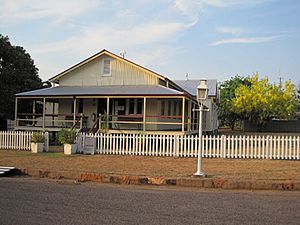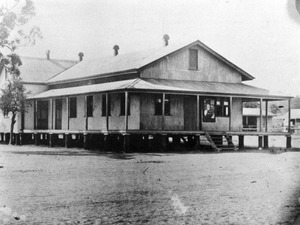Croydon Court House facts for kids
Quick facts for kids Croydon Court House |
|
|---|---|

Court House, 2011
|
|
| Location | Samwell Street, Croydon, Shire of Croydon, Queensland, Australia |
| Design period | 1870s - 1890s (late 19th century) |
| Built | 1887 |
| Architect | Colonial Architect's Office |
| Official name: Court House (former) | |
| Type | state heritage (built) |
| Designated | 21 October 1992 |
| Reference no. | 600437 |
| Significant period | 1880s (historical) 1887-1890s (fabric) |
| Significant components | court house, office/s |
| Lua error in Module:Location_map at line 420: attempt to index field 'wikibase' (a nil value). | |
The Croydon Court House is an old building in Croydon, Queensland, Australia. It used to be a courthouse where legal cases were heard. It was designed by the Colonial Architect's Office and built in 1887. Today, it's listed on the Queensland Heritage Register, which means it's a special historical place protected since 1992.
Contents
A Golden Past
The old Court House was built in 1887. It was part of a group of government buildings on the main street of Croydon. At that time, Croydon was a very busy gold mining town.
The Gold Rush Begins
In the early 1880s, gold was found near Croydon Downs Station. In October 1885, a big gold discovery was announced. This caused many people to rush to the area. On January 18, 1886, Croydon was officially named a goldfield. The town was quickly mapped out. By the end of 1886, about 2,000 people lived in the Croydon goldfield.
Building the Court House
The Queensland Government needed to set up services for the growing town. They needed a place for police and a court. A special area was set aside for the Court House next to the police station. It was hard to manage a large area with people spread out and limited money. Also, transport was difficult before good roads and railways were built.
The government decided to create regional courts. These courts would have police offices, places for officials to stay, and lockup cells. Visiting judges or magistrates would travel to these courts. Plans for a new court house were drawn up. It would include rooms for visiting judges and a Clerk of Petty Sessions. This person managed the court's daily paperwork. The builders Edward and James Headland won the contract to build it for £1875.
The Court House Opens
The court house was finished in May 1887. However, the first court case was held there earlier, on January 24, 1887. This shows how urgently the building was needed. The building was made with a timber frame and covered with corrugated iron. This material was used because good timber was hard to find in the area. Also, termites were a big problem, and corrugated iron helped protect the building.
Croydon had a mining warden who visited from Georgetown. Wardens often had offices in court buildings. Soon after the court house was built, it was made bigger. New offices were added for the Mining Warden and the Registrar. This made the total cost of the building £2075. More cells and stables for police horses were also added nearby. This happened as the need for police services grew.
Growth and Decline
Croydon became a local government area in 1887-1888. It was declared a municipality in 1892. New police barracks were built in 1896, and more cells in 1897. By 1897, Croydon had grown a lot. It had the third-largest population in North Queensland. Only Townsville and Charters Towers were bigger. The police, court, and town hall buildings along the main street show how important these services were for fast-growing towns.
In 1897, a big fire destroyed much of Croydon's town centre. This might have been the start of the town's decline. Unlike Charters Towers, the gold in Croydon was not found in deep reefs. This meant there wasn't enough work for many miners for a long time. The population began to drop.
The area was renamed the Shire of Croydon in 1903-1904. By 1907, most of the gold was gone. Croydon became a centre for farming and ranching instead of gold mining. By 1912, the old gold warden's offices were being used by a surveyor. After World War I, gold mining almost stopped. The last court case was held in 1926. Rooms at the back of the building were used for storage. The Clerk of Petty Sessions kept an office there until the 1940s.
Saving the Building
By 1961, the building was empty and falling apart. The Croydon Shire Council bought it on June 13, 1961. Money was received from the National Estate to help save the building. Major repairs were done in 1980. Since then, the building has been a tourist attraction. It helps tell the story of Croydon's busy gold rush days. In 1999, work began to turn the building into a court house museum.
What the Court House Looks Like
The Croydon Court House is a single-storey building. It stands on low stumps and faces Samwell Street, the main street of Croydon. Next to it are the old police buildings and the former town hall.
The court house has a timber frame. Its walls and gabled roof are covered with vertical corrugated iron. A verandah, which is like a covered porch, goes around three sides of the court room. It has its own roof supported by posts. The main entrance is in the middle and has low steps.
Behind the main court room are three sections of offices. They are set at right angles to the court room. These sections are similar in shape and are parallel to each other. The first two office sections are separated by a hallway with a curved corrugated iron roof. They also have a verandah at the back. Behind these are two more offices with a space between them that leads to the back verandah.
Windows on the end walls have sun hoods to block the sun. The building has good ventilation. There are panels with adjustable slats (louvres) in the upper parts of the end walls. There are also vents on the roof.
The main court room has a curved ceiling. It gets plenty of light from windows at the front and sides. The inside walls are not covered, so you can see the corrugated iron. However, the wall behind the judge's bench is made of horizontal timber boards. The court room still has its original furniture. This includes the judge's bench, the box where the person on trial would stand, the witness stand, and the jury bench.
Why the Court House is Special
The former Court House was added to the Queensland Heritage Register on October 21, 1992. It is considered important for several reasons:
- It shows how Queensland's history unfolded.
The Croydon Court House helps us understand how Croydon and the surrounding area grew. It shows how important the town was during the gold rush. It also shows how justice was handled in faraway places. It reminds us that goldfields like Croydon could become important very quickly, but sometimes their importance didn't last long.
- It is a great example of its type of building.
The Court House is a good example of a small regional courthouse from its time. It has a large court room with offices for judges and court staff at the back. The fact that it also has offices for mining officials is typical for courthouses in mining areas.
- It has special beauty and design.
This building is one of several public buildings along Croydon's main street. These include the police station, police residence, and the shire hall. Together, they give the town its unique look and feel.
- It has a strong connection to the community.
The Croydon Court House has been important to the people of Croydon and the surrounding area for a long time. It was the main place where justice was carried out.


